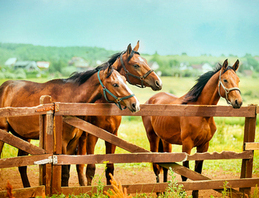Worms / Internal Parasites in Horses
This article looks at the most common worms that affect horses, how they reproduce, what impacts they have on a horse's health, what signs to look for, and what natural remedy in the Natural Pet Agripathics range has to help your horse with worm burden effectively.
Worms can cause many problems with horses. Some can be mild, while others can be severe and even life-threatening. Below are detailed some of the most common worms.
Small Strongyles Cyathostomin spp
The most common intestinal worm found in horses. Adults of this worm produce eggs in the intestine, where they are passed out in the faeces. Then, 1 to 2 days later, they hatch into larvae, which will stay here and grow in the faeces till they are at stage 3, where they can infect the next horse that ingests it. Once ingested, they travel to the lower intestine, burrowing into and becoming encysted in the intestinal wall. This process involves them developing a fibrous capsule around themselves from stage 3 to stage 4, which can take several months. After this stage, they emerge as adults and travel back into the intestinal space, where they begin to lay eggs, finishing the cycle.
If the horse is overburdened with encysted larvae, it can reduce the absorption of nutrients. The larvae can also go into a dormant stage called hypobiosis, which can last for months to years, waiting for a trigger, usually, environmental to wake up.
Small strongyles can cause severe damage to the wall of the intestines.
Clinical signs can be diarrhoea, weight loss, shock and even death.
Large Strongyles Strongylus edentatus, Strongylus vulgaris, Triodontophorus spp
Also known as the blood worm, palisade worm, or red worm. They are blood-sucking parasites in the cecum of the horse's digestive system.
The eggs from an infected horse are passed through the faeces, where 1 to 2 days later, they hatch into larvae. They will stay here and grow in the faeces till they are at stage 3, where they can infect the next horse that ingests them. If eaten before this stage, they will be passed through the horse, causing no damage. Once the larvae are ingested, they end up in the intestine, mainly the cecum, ileum and colon, where they burrow into the blood vessels, particularly the tiny arteries that supply the intestine blood. Here they cause inflammation and blockage of the blood supply, which results in colic symptoms. Once in the blood vessels, they moult and develop into stage 4.
From there, they work along the arteries until they reach a major junction branching from the aorta. When they arrive at these junctions, they are only 1-2mm long but grow to about 15mm long, where they fill up the artery and cause blood clotting or thrombus, where blood can't get through. If the blockage is to a large blood vessel in the intestine, the horse may develop peritonitis, which can be fatal.
After several months the larvae return to the intestine, where they can further develop into adults and start the cycle again.
Clinical signs can be fever, loss of appetite, emaciation, depression, abdominal pain and discomfort, colic and occasionally, a horse may develop diarrhoea.
Tapeworm Anoplocephala perfoliata
A cestode flatworm consists of a head and segments. It attaches to the intestine of its host and absorbs nutrients through the skin. Depending on the species, they can grow between 70cm to 10 metres long.
Each tapeworm is made up of many segments. The head has six rows of teeth with suckers and muscular grooves which is how it attaches to the horse's intestine. They do not contain a digestive system but absorb nutrients from their host through their skin. Each new segment grows from the head end, with the more mature ones at the tapeworm's end. Each segment contains its own female and male reproductive organs. So that it can produce a large number of eggs. Segments then break off from the tapeworm and are passed through the faeces, which are eaten by forage mites living on the pasture. The horse then grazes the pasture and is reinfected. After that, the cycle starts over again.
Clinical signs include failure to grow or do well, irritability, increased appetite, dull coat, stomach upset / colic and diarrhoea.
Roundworm Parascaris equorum
More common in young horses, two years and under, before their natural immunity has matured. The adult roundworm lives in the small intestine of the horse, where they produce its eggs. A single female can lay anything from 100,000 to 200,000 eggs a day. These eggs are passed out through the horse's faeces, where they can survive for up to 10 years in the environment.
A horse eats the eggs, and once in the intestine, they hatch into larvae which penetrate the intestinal wall. Next, they travel through the hepatic vein to the horse's liver, spending the next 7-10 days feasting. They then continue their journey to the lungs, eating there for another 14-21 days. It is here where the most damage is done, the liver can regenerate, but the lungs can become permanently damaged, as when they heal, they produce scar tissue.
Once they have finished here, they penetrate the lung wall into the air sack. The body's immune response to this attack is to destroy the alveoli, which can lead to young horses developing pneumonia. Once in the alveoli, they travel to the bronchioles, to the bronchi, and then the trachea, here they cause irritation and make the horse cough, so they are thrown into the back of the throat, where they are re-swallowed back into the stomach as mature adults to start the cycle again.
Clinical signs include coughing and nasal discharge, weight loss, a rounded belly, and colic.
Pinworm Oxyuris equi
It is a less common problem in horses. The adult pinworm lives in the lower intestine of the horse. Once it is relaxing, the female pinworm emerges out of the rectum and lays her eggs with a sticky yellow substance around the anal area of the horse.
The pinworm doesn't cause any harm to organs or the health of the horse, the main result is irritation to the rectum area, and because they live their entire cycle in the lower intestine, they have minimal clinical signs – itching and rubbing of the tail area.
Bots fly Gasterophilus intestinalis and Gasterophilus nasalis
These are a fly rather than a worm, but their life cycle causes them to be treated under the worming arena. A female adult botfly has no mouth and cannot feed. Instead, she lives on internal reserves, only long enough to lay her eggs on horses, mainly around the mouth, eyes and legs. The moisture from the skin and saliva allows the eggs to hatch into larvae. With the horse licking these areas, they ingest the eggs and larvae, which travel to the stomach and attach themselves to the mucus lining. After about ten months, they detach from the lining and exit the horse via faeces, where the larvae burrow into the ground to develop into a mature botfly over 3-10 weeks to start the life cycle again.
Clinical signs can be minimal, including inflamed mouth and stomach irritation. You can also see signs of botfly eggs on the horse's hair.
Resistance
With many different commercial drugs out there for eliminating worms from your horse, there is becoming the problem of resistance. This is where a horse is treated with a commercial wormer, and there ends up being a small group of worms that are treated but not killed. They go on to reproduce and slowly develop a resistance to the worming treatment. Unfortunately, the commercial worming treatment has become more potent and dangerous for your horse.
What can you do to help?
Do not overstock paddocks. Cleaning up poo 1-2 times a week will help interfere with the life cycle. Also, spread your rotation out between paddocks if you can. Finally, regularly groom your horse, looking for signs of worm infestations.
Natural Pets equine range has a homeopathic worming remedy called Horswrm, explicitly designed for horses' internal parasite complaints. It has the common worm-repelling remedies plus also worm species-specific nosodes. In addition, it can be individually feed or trough treated.
All worming should be done around the full moon, as this is when the worms are at their most active, and you will get a better expulsion rate.
Recent Articles

20% Off
All Cat Remedies
Lorem Ipsum is simply dummy text of the printing and typesetting industry. Lorem Ipsum has been the industry's standard dummy text ever since the 1500s, when an unknown printer took a galley of type and scrambled it to make a type specimen book. Lorem ipsum dolor sit amet, consectetur adipiscing elit. Vivamus leo ante, consectetur sit amet vulputate vel, dapibus sit amet lectus.



 Earn loyalty points everytime you shop
Earn loyalty points everytime you shop

